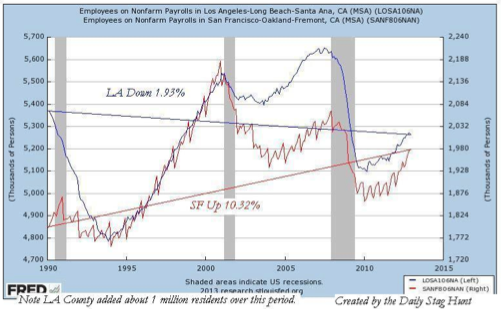Below we show employment growth in Los Angles and San Francisco since 1990. Note LA County has added about 1 million residents over this period. San Franscisco has about flatlined.
This trend is larger than the recent financial crisis. It’s larger than a business tax rate or industrial policy of a single city. Much larger.
*Note this graph doesn’t refer to the cities of San Francisco or Los Angeles but rather their Metropolitan Statistical Areas, a wonky term for their greater regions (here’s the map for LA) and the locus of economic data. It’s important to remember that we’re talking about California government and it’d be far too logical to have the boundaries of local government cohere with areas of economic measurement.
Currently there’s a race going on to be LA’s next mayor. Let’s remember though that the LA business climate is a function of much more than the city — there’s the county, 87 other cities and a host of other municipalities and agencies with crucial impact for job creation (thinking of for instance the AQMD, SWRCB, MWD, SCCPA, etc.). And lest you think that those entities are just archane vehicles that only a wonk would care about, these are the basic institutions that ensure that your lights go on when you flip a switch, that the air is breathable, and that clean water comes out of your tap.
Many of the challenges we face in Southern California are regional, and the logic behind our region’s dismal economic performance these past two decades is deeply structural. A problem articulated (ahem) in my book A New California Dream:
Consider traffic, which second to Hollywood, is probably LA’s defining attribute (at least in the popular image). The Metropolitan Transportation Authority, the County government, and the 88 incorporated cities in LA County each have a say in the region’s transportation policy (through a minimum of zoning). And thus making the regional improvements that Greater Los Angeles needs essentially requires unanimity across a huge array of independent organizations, each with their own vision for the region and idea of how to achieve it. Like LA’s famous freeway system, our political institutions are proving incapable of dealing with the rapidly changing demands of the twentyfirst century. Instead we find ourselves stuck in bumper to bumper gridlock.
Looking deeper at our transportation problem, here’s a thought: how might we leverage the advent of self-driving cars to reimagine transporation infrastructure? The basic challenge hasn’t change — getting people from where they are to where they need to go — but here’s a technology that might revolutionize how that happens and how public servants tackle that basic problem. Remember Los Angeles has been a pioneer in this area before, building in fact the first freeway ever in the 110.
Or think about Los Angeles’ immense talent in creative design and let’s ask ourselves: how might we leverage that asset to capture the potential of additive manufacturing? We certainly could use the jobs.
Or look at the revolution going on in education right now, as eloquently articulated by Sir Ken Robinson in this Ted talk. Very much big picture, yet when you look at the depth of Los Angeles’ education problem — only 6 in 10 students in LAUSD graduate on time — and the historical nature of the problem, it becomes clear that we need big thinking.
Note what I am calling for here is the new and essentially unproven. That’s the nature of a frontier though. So why not, as Governor Brown suggests, have courage to confront our challenges and the boldness to tap into the pioneering spirit that made California — and Los Angeles — great?
Crossposted on The Daily Stag Hunt


